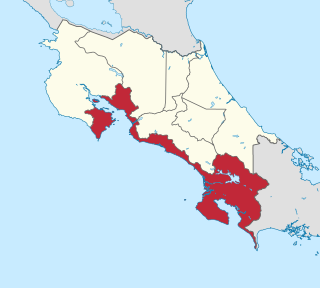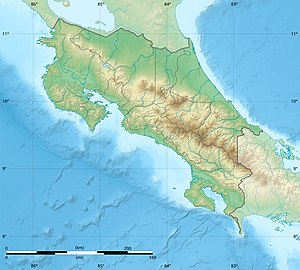
Guanacaste is a province of Costa Rica located in the northwestern region of the country, along the coast of the Pacific Ocean. It is bordered by Nicaragua to the north, Alajuela Province to the east, and Puntarenas Province to the southeast. It is the most sparsely populated of all the provinces of Costa Rica. The province covers an area of 10,141 square kilometres (3,915 sq mi) and as of 2010, had a population of 354,154, with annual revenue of $2 billion.

Puntarenas is a province of Costa Rica. It is located in the western part of the country, covering most of Costa Rica's Pacific Ocean coast, and it is the largest province in Costa Rica. Clockwise from the northwest it borders on the provinces Guanacaste, Alajuela, San José and Limón, and the neighbouring country of Panama.

Liberia is a district and the largest city in the Guanacaste Province of Costa Rica, located 215 kilometres (134 mi) northwest of the national capital, San José, which is also in the Guanacaste canton. It is a major center for the country's tourism industry.

Puntarenas is a city in the Puntarenas canton of Puntarenas Province, on the Pacific coast of Costa Rica. As the seat of the Municipality of Puntarenas canton, it is awarded the title of city, which is made from the Puntarenas, Chacarita and El Roble districts. And as the city of the first canton of the province, it is the capital city of the Puntarenas Province as well, according to the Administrative divisions of Costa Rica.
National System of Conservation Areas is part of the Ministry of Environment and Energy (MINAE) of Costa Rica. It is the administrator for the nation's national parks, conservation areas, and other protected natural areas.

Chira Island is a 4,300-hectare (11,000-acre) Costa Rican Pacific island located at the upper end of the Gulf of Nicoya it is also as Chira a district of the Puntarenas canton, in the Puntarenas province of Costa Rica.

The Gulf of Nicoya is an inlet of the Pacific Ocean. It separates the Nicoya Peninsula from the mainland of Costa Rica, and encompasses a marine and coastal landscape of wetlands, rocky islands and cliffs.

The Nicoya Peninsula is a peninsula on the Pacific coast of Costa Rica. It is divided into two provinces: Guanacaste Province in the north, and the Puntarenas Province in the south. It is located at 10°N 85.4166667°W. It varies from 19 to 37 miles (60 km) wide and is approximately 75 miles (121 km) long, forming the largest peninsula in the country. It is known for its beaches and is a popular tourist destination.
Iguanita Wildlife Refuge is a wildlife refuge in the Guanacaste Conservation Area located in the Guanacaste Province of northwestern Costa Rica.
Puntarenas is a canton in the Puntarenas province of Costa Rica. The head city is Puntarenas.

Esparza is a canton in the Puntarenas province of Costa Rica. The head city is Esparza in Espíritu Santo district.

The following is an alphabetical list of topics related to the Republic of Costa Rica.

Cabuya is a small fishing village on the Nicoya Peninsula of Costa Rica.
Protected areas of Panama include:
Lepanto is a district of the Puntarenas canton, in the Puntarenas province of Costa Rica.
Paquera is a district of the Puntarenas canton, in the Puntarenas province of Costa Rica.
Cóbano is a district of the Puntarenas canton, in the Puntarenas province of Costa Rica.

National Secondary Route 160, or just Route 160 is a National Road Route of Costa Rica, located in the Guanacaste, Puntarenas provinces. The road is between Naranjo ferry terminal and Route 21 in Nicoya peninsula, and again with Route 21 at Santa Cruz, Guanacaste.
Chora Island Wildlife Refuge, is a protected area in Costa Rica, managed under the Tempisque Conservation Area, it was created in 2002 by decree 30719-MINAE.
National Primary Route 21, or just Route 21 is a National Road Route of Costa Rica, located in the Guanacaste, Puntarenas provinces.














